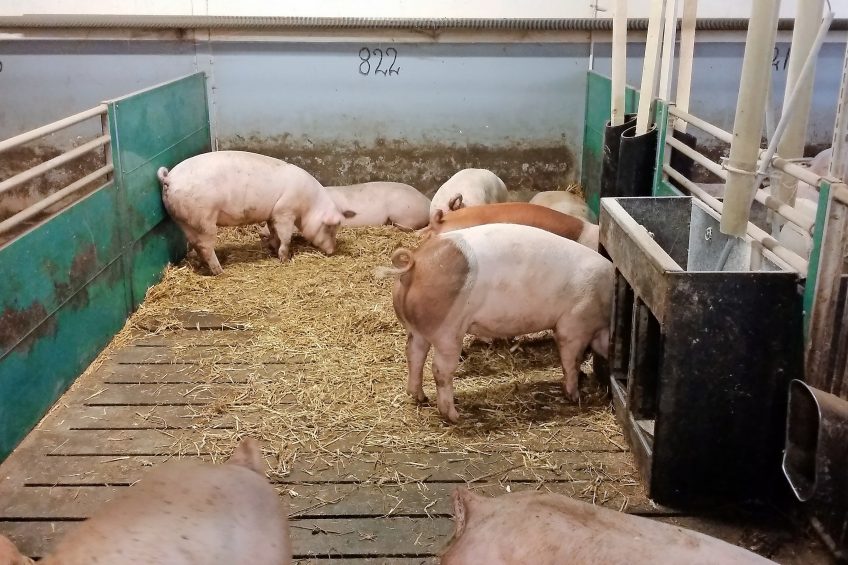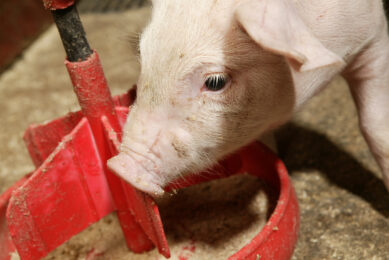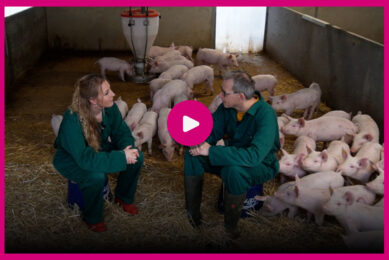How can enrichment help to reduce tail docking?

In several episodes, leading welfare researchers explain the results they obtained within the international framework ‘FareWellDock’. This project investigates how to steer away from tail docking. Swedish and Danish researchers took a look at straw – does its use reduce the occurrence of tail biting?
Injurious tail biting is commonly seen in both weaner and finisher pig herds. Tail biting is associated with pain and stress for the pig. In addition, tail bitten pigs may have reduced growth, may suffer from infections and may eventually be culled, and thus tail biting may also represent an economic loss for the farmer.
Therefore, tail biting is a problem for both the pigs and the farmers. In most countries tail docking is routinely used to prevent tail biting, except in Sweden, Finland and Switzerland, where tail docking has been completely banned.
Can tail docking be substituted?
What is needed are preventive measures that are as equally effective as tail docking in reducing the risk of injurious tail biting. Science suggests that lack of proper manipulable material is one of several major risk factors for tail biting. A large experimental study was therefore carried out at Aarhus University, Denmark, to compare the relative efficacy of tail docking with that of straw allocation and reduced stocking density.
The aim was to investigate if one or a combination of these preventive measures were equally as effective as tail docking to reduce risk of tail biting.The study included 112 finishers pens from four batches over a one-year period of which injurious tail biting occurred in 55 of these pens. The results showed that a moderate amount of straw (150 g/pig/day) reduced the risk of injurious tail biting by more than two-fold, while docking seemed to be more effective as it reduced the risk by more than four-fold.
Several preventive measures
Thus, to reduce the risk of injurious tail biting in undocked pigs, several preventive measures are needed. The study showed that a combination of straw and increased space (1.2 m2 per pig) reduced the risk in undocked pigs to the same level as found in docked pigs kept under high stocking density (0.72 m2 per pig) without straw. It should be emphasised that the study showed there is a risk of at least one occurrence of a pig in a pen with a bleeding tail wound. The study did not investigate the level of injurious tail biting after the first event had occurred.
Production conditions used in Sweden and Finland, where tail docking is not performed, is amongst others characterised by a stocking density of about 0.9 m2 per 90kg pig as well as the allocation of manipulable materials.
Figure 1 – The percentage of pigs occupied with straw directed behaviour with increasing amounts of straw at 40 kg and 80 kg live weight.

In Sweden and Finland, farmers report allocating on average of 30 to 50g of straw/pig/day. A survey in Sweden by the Swedish University of Agricultural Sciences (SLU) found that fewer injurious tail biting outbreaks occurred on farms using larger amounts of straw. Larger amounts of straw were mainly used on farms having scrapers in the slurry channels.
Why is straw provision effective and important?
Pigs have a strong behavioural need to perform exploratory behaviour. Under natural conditions, they spend the majority of their active time sniffing, rooting and chewing materials. Pigs explore to find food and to gather information about the environment. To provide a suitable outlet for exploratory behaviour under production conditions, materials have to be varied and complex, and are most effective when easily destroyed by chewing, or if they are edible. In barren environments, pigs will redirect the behaviour towards other pigs, which can eventually result in injurious behaviours such as tail biting.
Since straw is easily accessible in many countries it has often been given as manipulable material to pigs in scientific studies and it has proven effective in reducing risk of tail injuries. However, straw also has other positive effects for pigs.
Action points: Enrichment and tail biting
• To reduce injurious tail biting outbreaks, use straw; in combination with reduced stocking density it might be as effective as tail docking. For this purpose, the more straw the better;
• To ensure that sufficient straw is allocated, check that there is left-over straw before next day’s allocation;
• Examples of other preferred and effective materials are hay, silage, fresh pieces of soft wood, peat;
• Examples of less suitable materials: balls, hard wood, (short) chains, toys, rubber sticks;
• Materials should also be safe for the pig and the environment.
Need for exploration
Recently, the minimal amount of straw needed to fulfil pigs’ need for exploration was investigated at Aarhus University, Denmark. The study showed that increasing the amount of straw from 10 to up to 400g/pig/day had multiple positive effects by progressively reducing the occurrence of tail injuries and stomach ulcers, increasing growth rate, increasing straw-directed behaviour, and reducing redirected behaviours towards other pigs. These results were supported by results from the survey done at SLU also showing a gradually reduced occurrence of tail lesions with increasing amount of straw.
Under farming conditions, however, several factors can affect the pigs’ need for manipulable material. Therefore, an adequate screening method to assess the appropriateness of the level of material provided on-farm is needed. A screening method to assess the effect of straw amount was developed based on data from the above experimental studies.
The screening method scores the amount of unsoiled straw in the pen, pig behaviour and ear, tail and flank lesions. The method has been validated on commercial Swedish farms where scorings from pens with standard straw allocation was compared with scorings from pens with increased straw allocation. Preliminary results suggest that left over straw may be a promising candidate method to screen for appropriate level of straw allocation.
* The article was co-authored by Mona Lilian Vestbjerg Larsen, Margit Bak Jensen, from Aarhus University, Denmark, and by Torun Wallgren and Stefan Gunnarsson, Department of Animal Environment and Health, Swedish University of Agricultural Sciences, Skara, Sweden.
Funding for the research was granted by the European ERA network project FareWellDock, the Danish GUDP projects HeleHaler and StrawWell, and Aarhus University and Swedish University of Agricultural Sciences. More info: www.farewelldock.eu.











